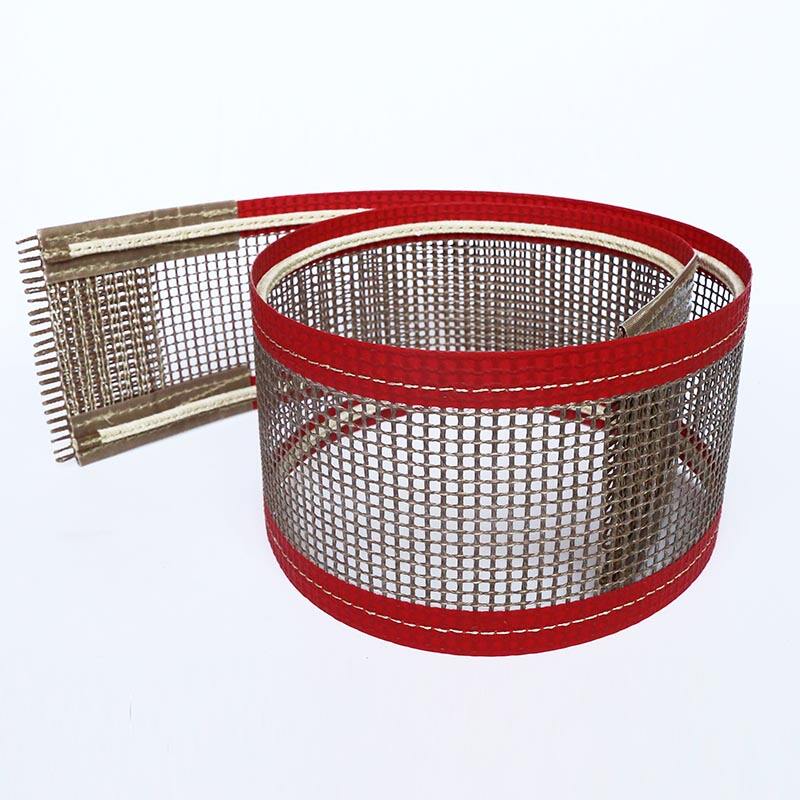When it comes to food processing, one of the significant revolutions has been started by PTFE coated fiberglass open mesh conveyor belt props. The industry which has been the biggest beneficiary from these special belts are food industries as it offers excellence of performance, hygiene and lifespan. To understand why they work wonders to improve efficiency, have incredible non-stick properties that are captivating food manufacturers worldwide as the conveyor systems of future; in this post we shall dive deeper into how PTFE coated mesh belts perform and serve delicious dishes one after another through their internal mechanisms, up close with its composition and convenient features which make them a boon for any modern day food industry.
The conveyor belt is the heart of every effective food processing line, and PTFE (Teflon)coated fiberglass open mesh belts are ideally suited to perform in this vital location. Its distinct open mesh design helps in the free air and moisture flow that allows quick cooling or drying of products after processing. This design prevents the product from sticking to it and also avoids debris collecting onhence continuous trouble free operation with minimum cleaning downtimes. In addition, its low coefficient of friction (CoF), which makes it slide effortlessly along the conveyor path itself for less energy use and greater operational efficiency.

The most important thing to consider these belts is it has excellent nonstick property among PTFE coated Belts. That is indispensable for the food industry where handling of sticky or delicate products (dough, confectionery and baked goods) are required. These belts also minimize product loss by preventing adhesion, and therefore require less-frequent belt cleanings (time-consuming tasks which can be expensive) than other conveyors. Moreover, the non-stick finishing stops bacteria from thriving which makes your food production side more hygienic and starts to follow health & safety rule strictly.

For food industry moving towards higher productivity, increased hygiene and sustainable practices PTFE coated mesh belts are the ultimate solution. With wide a range of temperatures (-70°C to 260°C), they are used in many food manufacturing processes across the stages from cooking, freezing and drying. Apart from this, PTFE chemical resistance makes it compatible with aggressive cleaning chemicals keeping your belt in service longer and minimizing replacement costs. The resulting mix of these qualities make PTFE coated mesh belts the bedrock upon which food conveying system for tomorrow will be laid.

This blending of PTFE and fiberglass results in a belting product that is light weight, but still very strong. For example, fiberglass has very high dimensional stability across extreme temperature variation and the belt will maintain its shape and not expand or contract through long term exposure to heat or cold. In addition, the consistent application of PTFE coatings provides uniform release and durability to these belts. Together, these materials provide for a belt that can handle even the heaviest of loads and will not stretch or deform - allowing products to be placed precisely on the conveyor and minimizing waste.
Based on the principles of taking roots in the land and looking to the global market, our products have been sold to more than 60 countries in Europe, America, Oceania, Middle East, Asia Pacific, etc., which are PTFE Coated Fiberglass Open Mesh Food Conveyor Belt, construction industry, automobiles industry, photovoltaic/solar energy industry, packaging industry, PTFE sunshades curtain and other fields.
VEIK's PTFE Coated Fiberglass Open Mesh Food Conveyor Belt and concentrations professionalism, dedications, and integrity in the future. Be attentive to the needs of the customers be attentive to the constant improvements of our quality and commitments to provides customers with top-quality services, create more energy efficient and more secure, eco beneficial long-term values that is sustainable for our customers.
Our firm has been in business for a long time. We have PTFE Coated Fiberglass Open Mesh Food Conveyor Belt, 2 coating lines, as well as 5 PTFE production lines for architectural elastomers. We have imported over 10 sets vertical and horizontal drying equipment, Germany Karl Mayer high-speed automatic warping machine, and Dornier taper looms that have wide widths. Our annual production capacity is one million square meters.
Our company has always remained committed to the principle of creating national brands and building century Veik. We put quality in the first place. Our products have been PTFE Coated Fiberglass Open Mesh Food Conveyor Belt, national glass fiber inspection and quality control of the product National quality control of building materials for fireproofing and inspection, and various other certifications and tests. Veik is an Jiangsu high-tech firm is located in the province.
Wide Application of non-stick ptfe coated or impregnated Fiberglass conveyor belts Easy To Maintenance For machines An open weave design is important for rapid and effective cleaning in areas where cross-contamination can cause real problems. The belt is permeable for water, detergents or steam and can be cleaned deep into the gaps of small food (bacteria) residues. Additionally, because PTFE is normally non-stick many substances do not stick to the belts surface making cleaning a lot simpler and removing the need (for further abrasive) clear methods that could damage other types of belt. The maintenance-friendly nature of the system minimises cleaning and maintenance times, minimizing downtime in production to ensure the highest levels of productivity while also meeting all applicable food safety standards.
In conclusion, PTFE coated fiberglass open mesh conveyor belts have revolutionized the food industry by bringing efficiency, hygiene and superior performance around. These new properties together with the existing super non-sticking, thermal stability and ease of washability set them as high-water mark for next generation conveyance solutions. The integration of such belts grows in importance as the food processing sector advances, an absolute must to safeguard and sustainably transmit our food from farm to fork.

